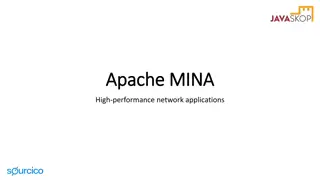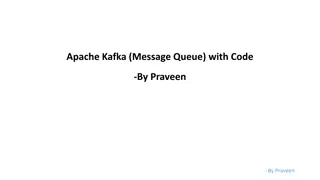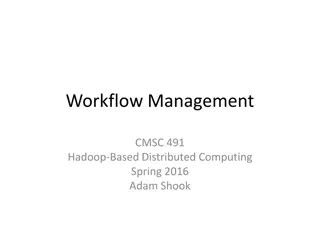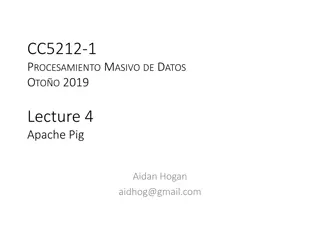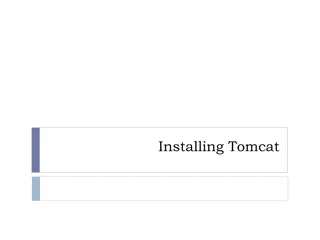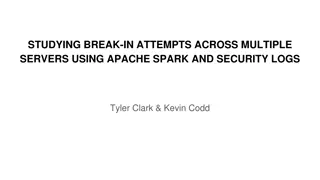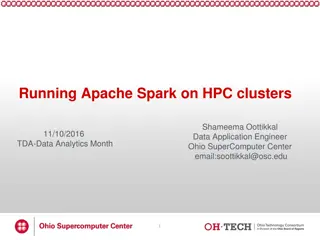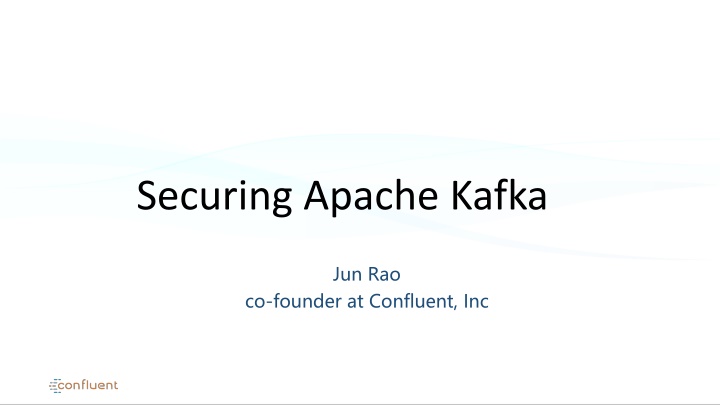
Apache Kafka Security Best Practices
Explore the necessary steps to secure Apache Kafka, including authentication, authorization, and SSL encryption. Learn about the performance impact of SSL and how to prepare for SSL implementation. Discover why SSL is essential for secure data transfer in Kafka clusters.
Download Presentation

Please find below an Image/Link to download the presentation.
The content on the website is provided AS IS for your information and personal use only. It may not be sold, licensed, or shared on other websites without obtaining consent from the author. If you encounter any issues during the download, it is possible that the publisher has removed the file from their server.
You are allowed to download the files provided on this website for personal or commercial use, subject to the condition that they are used lawfully. All files are the property of their respective owners.
The content on the website is provided AS IS for your information and personal use only. It may not be sold, licensed, or shared on other websites without obtaining consent from the author.
E N D
Presentation Transcript
Securing Apache Kafka Jun Rao co-founder at Confluent, Inc
Outline Kafka and security overview Authentication Identify the principal (user) associated with a connection Authorization What permission a principal has Secure Zookeeper Future stuff
Whats Apache Kafka Distributed, high throughput pub/sub system
Security Overview Support since 0.9.0 Access control on resources such as topics Enable sharing Kafka clusters Wire encryption btw client and broker For cross data center mirroring
Authentication Overview Authentication through SSL or SASL Broker support multiple ports plain text (no wire encryption/authentication) SSL (for wire encryption/authentication) SASL (for SASL authentication) SSL + SASL (SSL for wire encryption, SASL for authentication) Clients choose which port to use need to provide required credentials through configs
Why is SSL useful 1-way authentication Secure wire transfer through encryption 2-way authentication Broker knows the identity of client Easy to get started Just involve client and server
Subsequent transfer over SSL Data encrypted with agreed upon cipher suite Encryption overhead Losing zero-copy transfer in consumer
Performance impact with SSL r3.xlarge 4 core, 30GB ram, 80GB ssd, moderate network (~90MB/s) throughput (MB/s) CPU on client CPU on broker producer (plaintext) 83 12% 30% producer (SSL) 69 28% 48% consumer (plaintext) 83 8% 2% consumer (SSL) 69 27% 24% Most overhead from encryption
Preparing SSL 1. Generate certificate (X509) in broker key store 2. Generate certificate authority (CA) for signing 3. Sign broker certificate with CA 4. Import signed certificate and CA to broker key store 5. Import CA to client trust store 6. 2-way authentication: generate client certificate in a similar way
Configuring SSL No client code change; just configuration change. Client/Broker ssl.keystore.location = /var/private/ssl/kafka.server.keystore.jks ssl.keystore.password = test1234 ssl.key.password = test1234 ssl.truststore.location = /var/private/ssl/kafka.server.truststore.jks ssl.truststore.password = test1234 Broker listeners = SSL://host.name:port security.inter.broker.protocol = SSL ssl.client.auth = required Client security.protocol = SSL
SSL Principal Name By default, the distinguished name of the certificate CN=host1.company.com,OU=organization unit,O=organization,L=location,ST=state,C=country Can be customized through principal.builder.class Has access to X509Certificate Make setting broker principal and application principal convenient
What is SASL Simple Authentication and Security Layer Challenge/response protocols Server issues challenge and client sends response Continue until server is satisfied Different mechanisms GSSAPI: Kerberos (supported since 0.9) Plain: cleartext username/password (supported since 0.10) Digest MD5
Why Kerberos Secure single sign-on An organization may provide multiple services User just remember a single Kerberos password to use all services More convenient when there are many users Need Key Distribution Center (KDC) Each service/user need a Kerberos principal in KDC
How Kerberos Works Create service and client principal in KDC Client authenticate with AS on startup Client obtain service ticket from TGS Client authenticate with service using service ticket
SASL handshake Client Broker Connection Mechanism list Selected mechanism & sasl data Evaluate and response Sasl data Client authenticated
Data transfer SASL_PLAINTEXT No wire encryption SASL_SSL Wire encryption over SSL
Preparing Kerberos Create Kafka service principal in KDC Create a keytab for Kafka principal Keytab includes principal and encrypted Kerberos password Allow authentication w/o typing password Create an application principal for client KDC Create a keytab for application principal
Configuring Kerberos No client code change; just configuration change. Broker JAAS file Client JAAS file KafkaServer { com.sun.security.auth.module.Krb5LoginModule required useKeyTab=true storeKey=true keyTab="/etc/security/keytabs/kafka_server.keytab" principal="kafka/kafka1.hostname.com@EXAMPLE.COM"; }; KafkaClient { com.sun.security.auth.module.Krb5LoginModule required useKeyTab=true storeKey=true keyTab="/etc/security/keytabs/kafka_client.keytab" principal="kafka-client-1@EXAMPLE.COM"; }; Broker JVM ClientJVM - Djava.security.auth.login.config=/etc/kafka/kafka_server _jaas.conf Broker config - Djava.security.auth.login.config=/etc/kafka/kafka_client _jaas.conf Client config security.inter.broker.protocol=SASL_PLAINTEXT(SASL_SSL) sasl.kerberos.service.name=kafka security.protocol=SASL_PLAINTEXT(SASL_SSL) sasl.kerberos.service.name=kafka
Kerberos principal name Kerberos principal Primary[/Instance]@REALM kafka/kafka1.hostname.com@EXAMPLE.COM kafka-client-1@EXAMPLE.COM Primary extracted as the default principal name Can customize principal name through sasl.kerberos.principal.to.local.rules
Supporting multiple SASL mechanisms Broker can support multiple SASL mechanisms sasl.enabled.mechanisms=GSSAPI,PLAIN By default, only GSSAPI is enabled Client only picks one SASL mechanism sasl.mechanism=PLAIN Defaults to GSSAPI 22
Authentication Caveat Authentication (SSL or SASL) happens once during socket connection No re-authentication If a certificate needs to be revoked, use authorization to remove permission
Authorization Control which permission each authenticated principal has Pluggable with a default implementation
ACL Alice is Allowed to Read from topic T1 from Host1 Principal Permission Operation Resource Host Alice Allow Read Topic:T1 Host1
Operations and Resources Operations Read, Write, Create, Describe, ClusterAction, All Resources Topic, Cluster and ConsumerGroup Operations Resources Read, Write, Describe (Read, Write implies Describe) Topic Read ConsumerGroup Create, ClusterAction (communication between controller and brokers) Cluster
SimpleAclAuthorizer Out of box authorizer implementation. CLI tool for adding/removing acls ACLs stored in zookeeper and propagated to brokers asynchronously ACL cache in broker for better performance.
Authorizer Flow Client Broker Authorizer Zookeeper configure Read ACLs Load Cache Request authorize ACL match Or Super User? Allowed/Deni ed
Configure broker ACL authorizer.class.name=kafka.security.auth.SimpleAclAuthori zer Make Kafka principal super users Or grant ClusterAction and Read all topics to Kafka principal
Configure client ACL Producer Grant Write on topic, Create on cluster (auto creation) Or use --producer option in CLI bin/kafka-acls --authorizer-properties zookeeper.connect=localhost:2181 \ --add --allow-principal User:Bob --producer --topic t1 Consumer Grant Read on topic, Read on consumer group Or use --consumer option in CLI bin/kafka-acls --authorizer-properties zookeeper.connect=localhost:2181 \ --add --allow-principal User:Bob --consumer --topic t1 --group group1
Secure Zookeeper Zookeeper stores critical Kafka metadata ACLs Need to prevent untrusted users from modifying
Zookeeper Security Integration ZK supports authentication through SASL Kerberos or Digest MD5 Set zookeeper.set.acl to true on every broker Configure ZK user through JAAS config file Each ZK path writable by creator, readable by all
Migrating from non-secure to secure Kafka Configure brokers with multiple ports listeners=PLAINTEXT://host.name:port,SSL://host.name:port Gradually migrate clients to secure port When done Turn off PLAINTEXT port on brokers
Migrating from non-secure to secure Zookeeper http://kafka.apache.org/documentation.html#zk_authz_mi gration
Future work More SASL options: md5 digest Performance improvement Integrate with admin api Delegation tokens
Thank you Thank you Jun Rao | jun@confluent.io | @junrao Meet Confluent in booth #758 Confluent University ~ Kafka training ~ confluent.io/training Confluent services ~ confluent.io/services Download Apache Kafka & Confluent Platform: confluent.io/download



